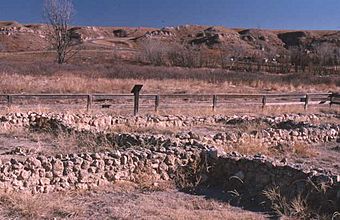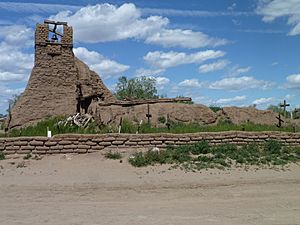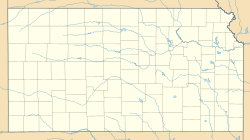El Cuartelejo facts for kids
|
El Cuartelejo
|
|

El Cuartelejo Ruins, Lake Scott State Park, Kansas
|
|
| Location | Western Kansas and eastern Colorado |
|---|---|
| Built | Apache of the Dismal River culture occupation between 1450 to 1650; Puebloans joined them between 1620 and 1680. |
| NRHP reference No. | 66000351 |
Quick facts for kids Significant dates |
|
| Added to NRHP | October 15, 1966 |
| Designated NHLD | July 19, 1964 |
El Cuartelejo, also known as El Quartelejo, means "old building" or "barracks" in Spanish. It is a special historical area in eastern Colorado and western Kansas. This region was once home to two Native American groups: the Plains Apache and the Puebloans.
In the 1600s, many Puebloans moved here. They were trying to escape difficult conditions and harsh rules from the Spanish in what is now New Mexico. They found a new home living alongside the Cuartelejo Apache.
One important site is an archaeological district in Kansas. It holds the remains of a village where Plains Apache and Puebloans lived together. This is the northernmost known pueblo (a type of village with stone or adobe buildings) ever found. It is also the only known pueblo in Kansas. You can find these ruins in Lake Scott State Park, about 13 miles north of Scott City, Kansas. The site is in Ladder Creek Canyon and is also called The Scott County Pueblo.
In 1964, the El Cuartelejo Archaeologist District (known as 14SC1) was named a National Historic Landmark. This means it's a very important place in American history. Most of the 26 archaeological sites here show signs of the Apache people from the Dismal River culture. They lived here from about 1450 until the mid-1700s. This group of Apache is often called the Cuartelejo band.
Contents
Native American Life at El Cuartelejo

People of the Dismal River culture lived at the Kansas site starting around 1450. By 1640, the western Apache people, who were semi-settled, lived in huts in El Cuartelejo in what is now eastern Colorado.
A Spanish explorer named Silvestre Vélez de Escalante wrote in 1778 about how some Christian Pueblo families from Taos left their homes. They went to the buffalo plains and built a fortified place, which was later called El Cuartelejo.
During the 1600s, Puebloan Native Americans faced many challenges from Spanish priests and rulers in New Mexico. The Spanish had a system called encomienda, which forced Pueblo people to work for Spanish landowners. These landowners were supposed to care for them, but they also tried to stop the Puebloans from practicing their traditional spiritual beliefs. Indigenous spiritual leaders faced harsh punishments for their beliefs. Because of this, there were many small uprisings against the Spanish.
Throughout the 1600s, Puebloans began moving north from New Mexico to live in the Great Plains of western Kansas and eastern Colorado. They joined the Cuartelejo Apache. This movement might have started as early as 1620. After a revolt in 1640, people from the Taos Pueblo joined the Cuartelejo Apache. Later, in 1664 and 1696, groups from the Picuris Pueblo and Tewa Puebloans (mostly from Santa Clara Pueblo) also moved to El Cuartelejo.
In 1642, a Spanish group led by Juan de Archuleta tried to capture and bring the Puebloan Native Americans back to New Mexico. Another expedition, led by Juan de Ulibarrí in 1706, also tried to bring refugees back. Ulibarrí's men visited at least five Cuartelejo villages, called rancherias. The main village was the site of the El Cuartelejo Ruins on Ladder Creek. Ulibarrí called it Santa Domingo and used it as his base to gather people from other villages.
In 1720, the Villasur expedition passed through El Cuartelejo. Their goal was to stop the French from gaining control in the Plains. However, they were defeated by the Pawnee in what is now Nebraska. French traders were also present at El Cuartelejo in 1727.
By the early 1700s, the Comanche, who were skilled horse riders, began to control the Arkansas Valley in eastern Colorado. This pushed the Apache out of southeastern Colorado by the mid-1720s. At the same time, French traders and their allies, the Pawnee and Wichita people, tried to control land to the east in Kansas. The Spanish military fought against these threats from the Comanche, French, and allied Native Americans. The Cuartelejo Apache left the Kansas area by the 1730s. They were pushed south by the Pawnee, Comanche, and Ute people. El Cuartelejo was abandoned. The Apache who survived these conflicts settled with the Jicarilla Apache near the Pecos Pueblo in New Mexico. By 1760, the Comanche were the main power in the region.
El Cuartelejo Pueblo and Archaeological Sites in Kansas
The El Cuartelejo site is located in Ladder Creek Canyon. This area had natural springs and streams, which were very important for life. The canyons and bluffs protected the village from harsh weather, creating a milder local climate. Stone found in the area was used to make tools and build structures. The fertile soil in the valley was perfect for farming. The area also had plenty of wildlife for hunting. This location was unique compared to the dry, flat High Plains of Kansas.
The ruins you can see today are from a former Puebloan structure. This building likely had seven rooms and measured about 16 by 11 meters (52 by 36 feet). It was probably built by the Taos or Picuris Puebloans before 1680. The design of the building is similar to pueblos found in the American Southwest. It included grinding troughs for preparing food, ovens, and slab-lined hearths for fires. There were also raised platforms used for sitting or sleeping. The building was made of plastered stone walls, and its roof was built with willow poles and plastered brush. People entered the building by climbing a ladder and going in through the roof, as there were no doors or windows. This structure is believed to be the northernmost pueblo ever built in North America.
Besides the main pueblo, there are twenty-five other related archaeological sites nearby. Most of the artifacts found belong to the Plains Apache of the Dismal River culture. However, there are also artifacts and pueblo structures from the southwestern pueblo cultures. The people used irrigation ditches from a nearby spring to water their crops.
The Steele Family and the Ruins
In 1888, Herbert Steele and his wife Eliza settled in western Kansas. They lived in a dugout home until their sandstone house was finished. On their land, which had been inhabited by Apache and Puebloans, they found Native American stone tools and other artifacts. They also noticed strange mounds of dirt. Curious about these findings, they contacted archaeologists. This led to the first excavations at the site around the turn of the century.
In 1922, the Steeles gave two acres of their land, including the pueblo ruins, to the Kansas Society of the Daughters of the American Revolution (DAR). They wanted the public to be able to visit and appreciate the site. The DAR then put up a monument in 1925. Today, the Steele family's old house is used as a museum for Lake Scott State Park.
Archaeological Digs at El Cuartelejo
From 1898 to 1900, archaeologists S. W. Williston and H.T. Martin from the University of Kansas excavated the site. They discovered that Apache people of the Dismal River culture lived at the site both before and after the Puebloans joined them. They uncovered the walls of the pueblo. Inside the rooms, they found animal bones, stone tools (called lithics), pottery, and a lot of corn. The pueblo's architecture clearly showed a southwestern origin. The pottery found included styles from both Northern Rio Grande Puebloans and Plains Native Americans. Based on charcoal and burnt artifacts, Williston and Martin believed the pueblo was destroyed by fire.
In 1939, the Smithsonian Institution conducted an excavation led by Waldo Wedel. Their work focused on areas south and north of the pueblo (site code 14SC1). A few meters from the pueblo, they found a circular bell-shaped pit and a storage pit. These pits contained hundreds of stone tools and about 4,000 pieces of Dismal River pottery. They also found pipe fragments similar to those from the northern Rio Grande pueblos. Other items found included charcoal, many animal bones, three Olivella shells, and other discarded items. The artifacts suggested that the Puebloan women continued to make pottery and cook in the same ways they did in their homeland.
The Nebraska Historical Society carried out more excavations in 1970, 1975, and 1976, led by A. T. Hill. They found a roasting pit beneath the pueblo. This showed that people of the Dismal River culture lived there before the Puebloans arrived. Artifacts from these digs included items from the Dismal River culture, Tewa Polychrome pottery from the southwest, and clay pipes. Since the 1970s, archaeologists from the University of Oklahoma and University of Iowa have continued excavations. Their work has helped to determine the exact dates when different groups lived at the site.
Reconstruction and Preservation
Over time, the archaeological sites have suffered damage. The pueblo ruins have been harmed, and some artifacts were removed by amateur archaeologists. After the excavations in the 1970s, parts of the pueblo walls were rebuilt. This reconstruction helps visitors see what the pueblo looked like in 1898.
Historic Landmark and Park
In 1964, the El Cuartelejo Archaeologist District was named a National Historic Landmark. This designation helps protect its valuable historical resources. The reconstruction of the walls was part of this effort. Informative historic markers have also been added to the site. The ruins are located within Lake Scott State Park. The Kansas State Society of the Daughters of the American Revolution owns the site, and the Kansas Department of Wildlife, Parks and Tourism maintains it.
At the El Quartelejo Museum, you can see a model of the pueblo, scenes of early Native American camps, and artifacts and fossils found at El Cuartelejo.
El Cuartelejo in Colorado
Some of the Puebloan refugees from New Mexico lived with Apache groups in what is now eastern Colorado. They settled near the Arkansas and Purgatoire Rivers, close to where Bent's Fort would later be built in the 1800s. Other Apache bands lived further north along the Smoky Hill and Republican Rivers in eastern Colorado. Pottery found at related archaeological sites belonged to the Padouca Apache and other Apache bands, as well as some Pueblo pottery. The Apache lived in rancherias, which were groups of huts or houses built around a central open area. They lived there except when they went to hunt buffalo in northeastern Colorado.
By 1640, a group from the Taos Pueblo moved to El Cuartelejo rancherías north of the Arkansas River. There were already Pueblo refugees living with the Apache there. By 1710, the Comanche and Utes began attacking Apache rancherias. In 1726, Padoucas from Kansas guided French traders west to El Cuartelejo. The French hoped to establish trade with the Spanish in New Mexico.
From 1710 to 1735, the Comanche frequently attacked Apache rancherias. The Palomas Apache joined the Cuartelejo Apache at El Cuarto in the Las Animas district along the Arkansas River. The Comanche attacked from the west, forcing many Apache bands, including the Carlanas and Chilpaines, out of the region. The El Cuartelejo settlements were abandoned. The Apache who survived moved and established new rancherias near the Pecos Pueblo in New Mexico. Some Apache also moved to the plains east of New Mexico.
In 1748, French traders occupied the El Cuartelejo rancherias and set up trading posts. They traded goods with the Comanche.
Images for kids
-
El Cuartelejo Ruins, Lake Scott State Park, Kansas
-
Old cemetery and ruins of old original church, Taos Pueblo, New Mexico.





